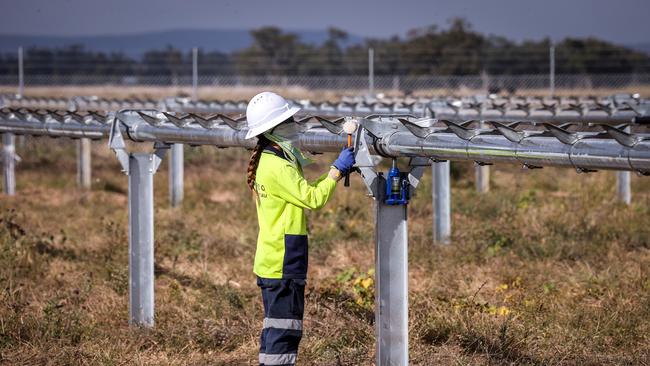Budget 2022: Energy transition could blow out debt, deficit

The cost of funding the transmission rollout to link renewable energy power to the grid is rising by the month. Labor promises the rollout will connect 26,000MW of cheaper renewable energy but it is behind schedule.
The longer the delay, the higher energy prices will be for Australians, pushing up inflation and the more pressure there will be on the government to spend more to fast-track its renewable infrastructure.
Labor roared into government on its promise of cheaper power bills from renewables, helped by a new teal agenda.
Gone in Labor’s narrative on Tuesday is any reference to the promise of a fall of $275 in household energy prices from December 2021 levels by 2025.
Treasury assumes that retail electricity prices will shoot up by an average 20 per cent in late 2022 and a further 30 per cent in 2023-24. Power prices will contribute three-quarters of a per cent and 1 per cent to inflation in 2022-23 and 2023-24.
The government can blame global energy prices, but the largest element of the bill, historically up to half of it, is the poles and wires cost. Renewable energy is only cheaper than fossil fuels once the infrastructure is built.
Yet the budget papers provide scant detail on Labor’s flagship Rewiring the Nation plan.

The $20bn in funding will provide cheap loans for infrastructure – a saving for these projects estimated at $4.7bn over the forward estimates. But interest rates have jumped and the government has missed the window for its own cheap financing of the $20bn.
With the Reserve Bank’s cash rate at 0.1 per cent during the Covid pandemic, a 30-year government bond charged 1 to 2 per cent in interest. Today’s yield on the 30-year government bond is 4.6 per cent.
Like the NBN financing, the $20bn is located off-budget, but the interest paid is on budget and affects the bottom line. Just for perspective, 4 per cent of $20bn is $800m in annual interest.
Labor hopes the funding will attract a further $58bn in private co-financing. But private developers will also want higher returns on investment in a higher-rate environment. And there is new competition for global capital from the US Inflation Reduction Act offering investment incentives. This transmission rollout is behind.
So far, the budget lists concessional financing for 80 per cent of the project cost of the Marinus Link from Tasmania to Victoria, $1bn for Tasmania’s Battery of the Nation projects, $1.5bn for renewable energy-zone projects in Victoria and $750m for the VNI interconnector between Victoria and NSW.
The VNI completion date is 2028, a year behind Labor’s previous modelling by RepuTex. There are no announcements around another nine projects modelled.
Transgrid chief executive Brett Redman recently estimated a one-year delay on the planned new transmission networks would mean an increase of $326 to the household bill. The concern for energy companies is if Wiring the Nation blows out and delivers unacceptably high retail power bills then the government will be forced to intervene.
The budget fires a warning shot. The government is investing $40.9m into gas regulation and is “exploring options for further reforms that may be required to ensure Australian customers have access to energy at reasonable prices”.
Energy transition should bring a step change in productivity growth with cheaper cost inputs. But Labor’s lowering of productivity growth from 1.5 per cent to 1.2 per cent reinforces the view that the fruits of transition are some way off.
In a world where central banks are battling to tame inflation, higher power prices are especially uncomfortable for the Treasurer.
This month, Jim Chalmers revealed he viewed electricity as the most problematic element of the inflation challenge over the next six to nine months.
To help smooth the energy transition strategy, the government also wants to introduce a capacity mechanism into the energy market that would pay generators of energy for the availability of firm power.
However, the idea, strongly supported by the Energy Security Board, has yet to secure agreement from Victoria, which refuses to include coal or gas generators in the mechanism.
Without such a mechanism, the risk of market failure in the grid rises as coal-fired power is withdrawn.
Victoria is looking the other way. Last week, the Andrews government – in full election mode – announced a renewable energy target of 95 per cent by 2035. It will spend an initial $1bn on renewable-energy projects in a plan to take back control of the state’s electricity grid.



A real risk of a debt and deficit blowout over the budget’s four-year horizon sits in the government’s plan for energy transition.